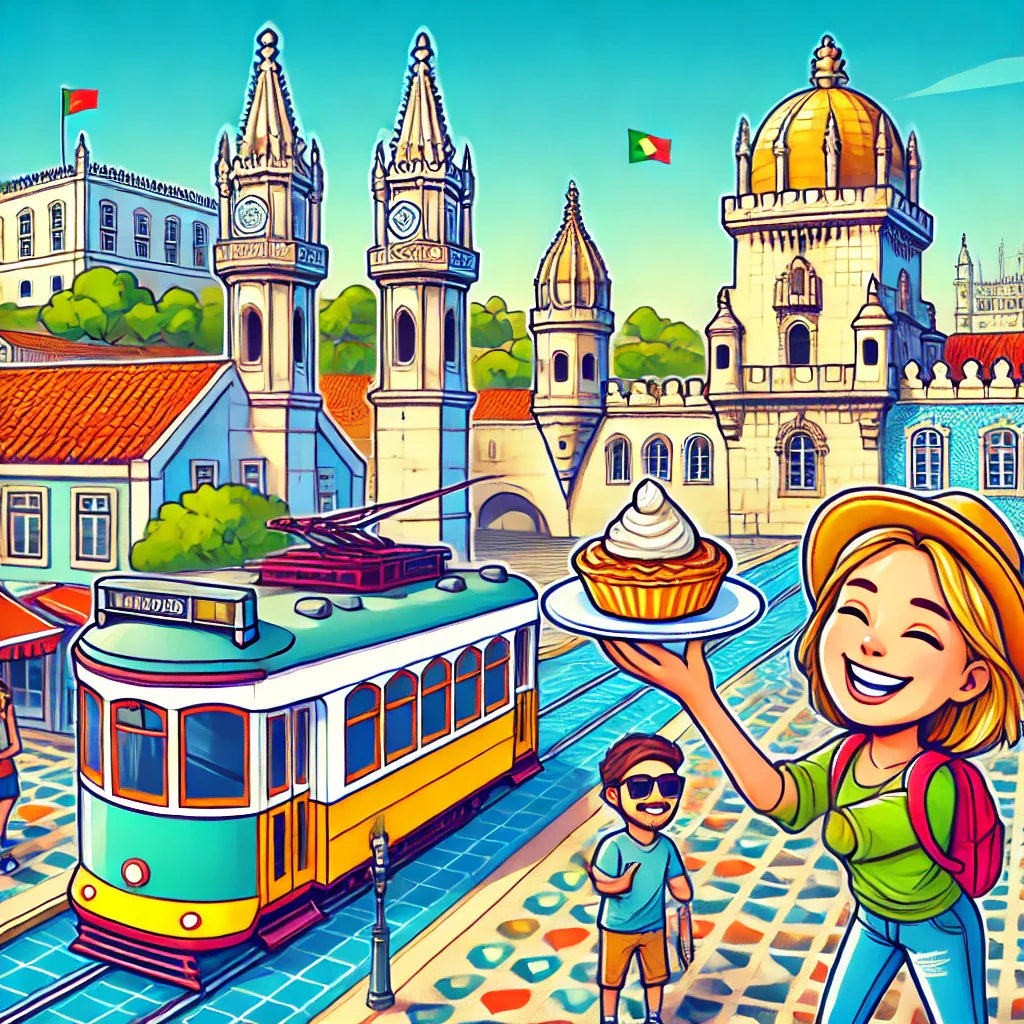
🌍 Lisbon: Where History, Art, and Pastries Collide! 🏰
Because where else can you walk through Roman ruins, sip espresso, and debate which custard tart is the best — all in the same afternoon? 😎
🏛️ A City Older Than Your Favorite Celebrity
Lisbon isn’t just old — it’s ancient. Julius Caesar made it a municipium (basically a Roman city) back in the day, which means it predates New York, Los Angeles, and probably most of your wardrobe. After the Romans came the Germanic tribes, then the Moors in the 8th century, and finally Afonso Henriques, who took back the city in 1147. Fast-forward to today: Lisbon is Portugal’s political, economic, and cultural center — and soon, with a little luck, your next vacation spot. ✈️
🏨 Where We Stayed – Four Seasons Ritz (Because Why Not?)
Luxury, comfort, and 40,000 square meters of marble — because if you’re going to splurge, do it right. The Four Seasons Ritz sits near Parque Eduardo VII and delivers on all fronts:
✅ Plush rooms? Check.
✅ Art-deco meets Louis XVI meets modern chic? Check.
✅ Michelin-starred CURA? Oh yes. 🍽️
✅ A rooftop running track overlooking the city? Yep — though the author did not break any records (but hey, effort counts!). 😆
💆♂️ Pro Tip: After a workout, hit the spa. Sauna, steam room, indoor pool — they’ve got it all. And if you’re really feeling fancy, book a one-on-one Pilates session.
🍽️ Eat Like Royalty (Or At Least Like a Local)
If you leave Lisbon hungry, you did it wrong.
👑 Belcanto – One of the top 50 restaurants in the world. Michelin-starred. Worth every penny.
🍲 CURA – Haute gastronomy at its finest.
🍽️ 100 Maneiras – Creative dishes with a touch of flair.
🍷 Mesa de Frades – Fado music + delicious food = perfection.
🥐 Pastéis de Belém – More on this below — because it deserves its own section.
🥮 Pastéis de Belém – A Custard Tart Worth Fighting Over
Fact: The monks at Jerónimos Monastery invented pastéis de nata in the 18th century because they had too many leftover egg yolks after starching clothes. (Yes, really.)
🛒 In 1837, the recipe was sold to the Fábrica de Pastéis de Belém, which now churns out 20,000+ tarts a day.
🍮 Crispy on the outside, creamy on the inside, sprinkled with cinnamon — it’s basically heaven in pastry form.
☕ Pro Tip: Pair it with a bica (Portuguese espresso). You’ll thank me later.
🏛️ Museums and Culture – Because You’re Classy Like That
National Museum of Ancient Art – 40,000 works of art, including Bosch’s Temptation of Saint Anthony.
Gulbenkian Museum – Run by one of the wealthiest foundations on Earth. Think Rembrandt, Monet, and more.
National Coach Museum – The world's largest collection of royal coaches. Yes, even royals needed Uber back in the day.
National Azulejo Museum – Gorgeous Portuguese tiles that deserve their own Instagram account.
Museum of Orient – Art, history, and a connection to Portugal’s maritime legacy.
🛡️ UNESCO-Listed Wonders – Because History Looks Good on Lisbon
🇵🇹 Belém Tower – Built between 1515 and 1520 to protect the harbor. Think of it as Lisbon’s medieval security system.
🇵🇹 Jerónimos Monastery – Stunning architecture, rich history — and hey, it gave us pastéis de nata.
🛒 Shopping – Bring an Extra Suitcase
🛍️ Avenida da Liberdade – Modeled after the Champs-Élysées in Paris, it’s lined with luxury shops and gorgeous cobblestone pavements.
👠 Chiado – Great boutiques, shoe stores, and jewelry shops. Also home to Belcanto.
💼 Baixa – Rebuilt after the 1755 earthquake, it’s packed with restaurants and shops.
💎 Armazéns do Chiado – Lisbon's version of a high-end department store.
🎭 Hidden Gems and Cool Finds
💀 Millennium BCP Foundation Archeological Site – Roman tunnels, fish-salting factories, and Christian burial grounds. Who knew ancient history could smell like sardines?
🎨 Ephemeral Museum – A museum dedicated to temporary art. Because sometimes things are beautiful because they don’t last.
🌊 Big Waves at Nazaré – Catch the world’s biggest surfable waves (up to 30 meters!) from October to March.
🏰 São Jorge Castle – The Oldest Part of Town
Perched on a hill with panoramic views, São Jorge Castle offers Roman and Moorish history, plus some serious photo ops.
🌅 Alfama – This hilly neighborhood survived the earthquake of 1755. Its narrow streets and Fado bars are pure magic.
🛡️ The 1755 Earthquake – Lisbon’s Worst Day (But Also Its Comeback Story)
A 9.0 magnitude quake + tsunami + fires = destruction.
👑 The Marquês de Pombal rebuilt the city in record time, giving Baixa its distinctive neoclassical style.
Now it's a bustling hub of shops, restaurants, and nightlife.
🚶♂️ Getting Around – Historic Trams Are Part of the Experience
Hop on Tram 28 — it winds through Lisbon’s prettiest neighborhoods.
Bonus: It’s an excuse to sit down after walking those hills. 😅
🍷 Nightlife – Because Sleep is Overrated
🍹 Pink Street – Neon lights + bars + clubs. It's like Vegas, but cooler.
🎶 Bairro Alto – Fado bars and live music.
🍾 Lx Factory – An old industrial complex turned into a trendy spot with bars, restaurants, and street art.
🏆 The Bottom Line – Lisbon = Magic
✅ Beautiful architecture.
✅ Delicious food (don’t forget the custard tarts).
✅ Friendly locals.
✅ Affordable prices.
✅ Big waves (if you dare).
Lisbon is like the friend who’s always up for an adventure — historic, cool, and effortlessly stylish. So pack your bags (and maybe an extra stomach for the pastries). Até já! 👋
⭐ Pro Tips:
- Wear comfortable shoes (those hills are no joke).
- Order more than one pastéis de nata — you’ll regret it if you don’t.
- Watch the sunset from São Jorge Castle — it’s next-level romantic.
- Don’t rush. Lisbon is a city meant to be savored.
✈️ Bonus: If you’re in town during football season, grab a ticket for a Benfica match. The atmosphere alone is worth it!
Other articles:
Quick links
Search
Privacy Policy
Refund Policy
Shipping Policy
Terms of Service
Contact us
About us
FUNanc!al distills the fun in finance and the finance in fun, makes news personal, and helps all reach happiness.

Got a thought? A tip? A tale? We’re all ears — drop it below.: